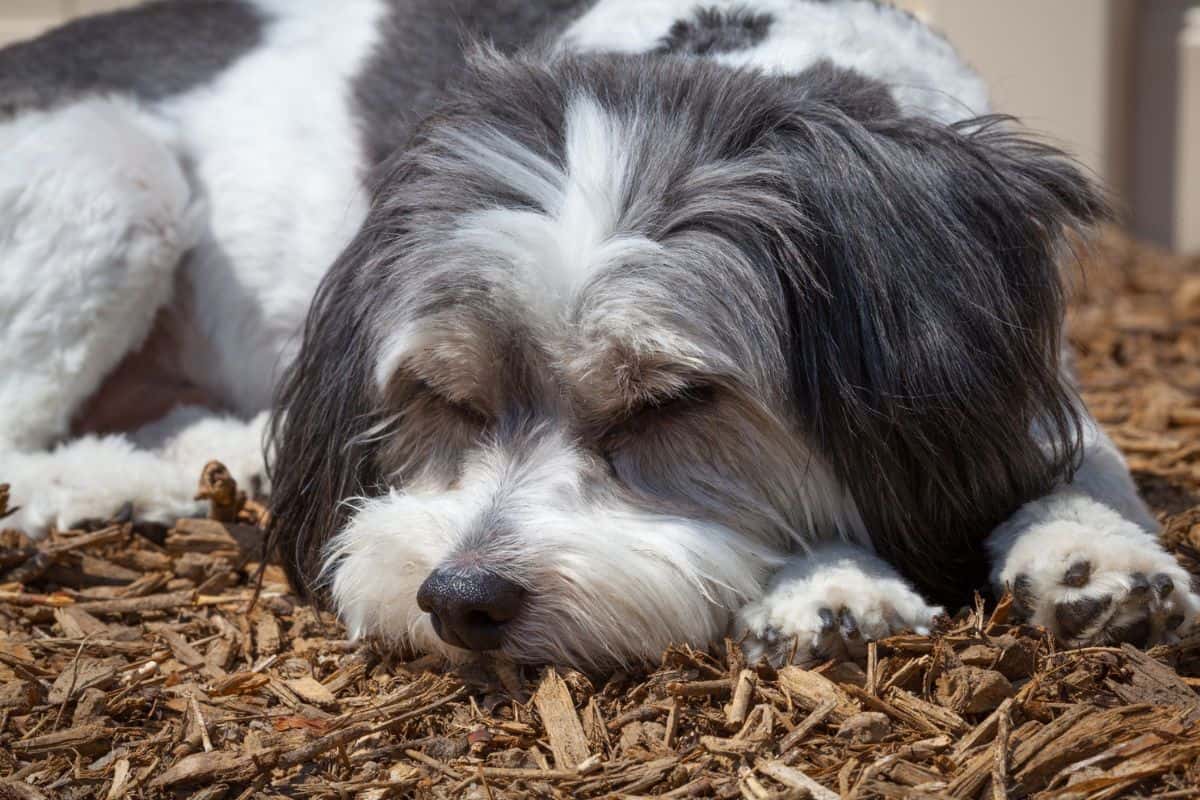Can You Have Rubber Mulch Around Dogs?

Yes. You can typically have rubber mulch in a garden with pets, as long as it isn’t made using harmful chemicals. According to the Environmental Protection Agency, rubber mulch is safe for people and pets and shouldn’t cause adverse health effects.
In addition, using rubber mulch is a great way to keep the ground below cooler and moist during periods of extreme heat, so that’s a positive.
On the other hand, if the weather is scorching, your rubber mulch may become too hot for your dogs to walk and play on. Therefore, we don’t recommend using it in large sections of your property.
Although it won’t melt, rubber can become a hot, uncomfortable surface for you and your pets to be on, which doesn’t make sense for a garden you’re supposed to enjoy.
It’s also worth mentioning that rubber mulch can be helpful for a dog waste area, as it won’t absorb smell or water/liquids. So, if you want to create an area for your dogs to go potty with rubber mulch, we don’t see an issue with this.
Is It Okay For Dogs To Chew On Mulch?
Even though your dog may not swallow the mulch in your yard, we don’t recommend letting it chew the pieces. It can be difficult to control how your dog behaves when you aren’t looking, so if anything, train yours to ignore the mulch pieces altogether.
According to Oodle Life, even chewing on wood chips can be dangerous for dogs. If your dog accidentally swallows a large enough wood chip, this can cause medical problems such as a blocked trachea or intestinal passages.
Besides suffocating on the wood chips, your pet can also have poisoning symptoms if the wood has recently been treated with pesticides.
So anytime you notice your pup going near the mulch and acting suspiciously, redirect their attention elsewhere.
Stephanie Devine
This article is a part of a larger Pet Pro Supply Co. series on Dog Parks. See the list of articles below:
The right surface can often mean the difference between a “destination space” with repeat visitors or a muddy mess with dog and patrons alike leaving the park looking like they just competed in a mud run.
The good news is that dog park surfacing doesn’t have to break the bank. We’re going to cover surfacing options to keep your dog park looking pristine (and your users at least a little tidier).
“Why do you even need surfacing? It’s a dog park!”
Dog parks have greatly evolved over the past decade. They began as simply an open space with a fence. Fast forward to today, they are true playgrounds for our furry friends. Some of the grandest dog parks out there feature agility equipment, shade, water features, waste stations, and yes, surfacing. Where we typically see surfacing at a child’s playground, it has become quite the norm in dog park settings. The reason for the trend is simple: Constant paw traffic on regular grass wears it down and creates large patches of dirt where grass cannot grow. When you add rain and a wide-open bathroom, these dirt patches become muddy pits that not only make the ride home a nightmare for your car’s interior, but it decreases the look and longevity of the park. A grass-only dog park could see closures while the park tries to re-grow grass, or the park could go unused because patrons do not want to deal with the dirt or trying to navigate their dog around the puddles.
What are the surfacing options and what is the most affordable?
The good news is there are a lot of surfacing solutions out there that can meet any budget. We are going to look at surfacing types by two categories: Unitary surfacing and Loose-fill surfacing. Unitary surfacing means the ground covering is solid, which means it doesn’t require maintenance to rake the product back into place, but it does require extra sanitation and cleaning due to drainage. Products that are considered unitary surfacing include turf, kennel tiles and grass. Loose-fill surfacing requires slightly higher maintenance as the material displaces as the dogs run about. This requires someone responsible for putting the product back in place and refilling when the product coverage is inadequate. Products that are considered loose-fill are wood chips, sand and gravel. We will explore each of these individually below.
Unitary Surfacing Types
Loose-Fill Surfacing Types
The good news is you don’t have to choose just one. A very popular solution is adding surfacing elements throughout the park in only certain high-use areas such as around agility equipment and at the entrance of the park. Using a combination of grass and other surfacing materials is an economical way to protect your investment.
A final note, it is important to remember, no matter the combination of surfacing you choose, to keep the patrons and users’ comfort in mind while selecting. Many surfaces like turf, kennel tiles, sand and gravel can get hot in the sun. If your dog park receives quite a bit of sun throughout the day, consider adding shade and water features to keep your park goers cool and happy, and coming back for more.

If you are still in the early stages of designing a dog park, take a look at this introduction to “How To Design a High Quality Dog Park” by BarkPark executive Madeline Dock.
If you are ready to start choosing equipment, check out Pet Pro Supply Co.s extensive collection of dog park equipment and out-of-the-box dog park kits!
Check out Playcores guide for a huge range of dog park equipment ideas and suggestions to utilize when you go to design your dog park.